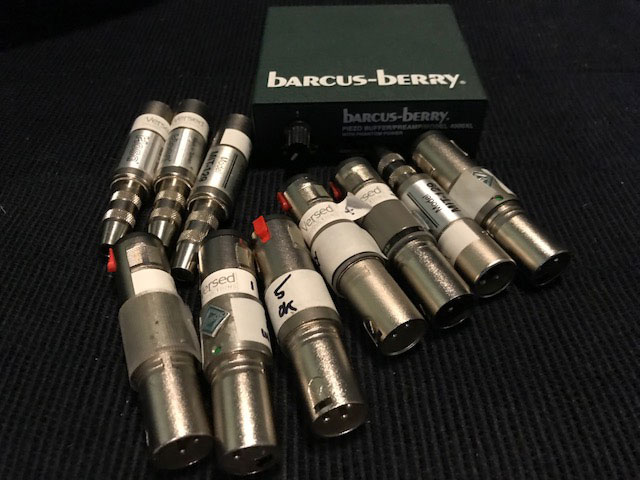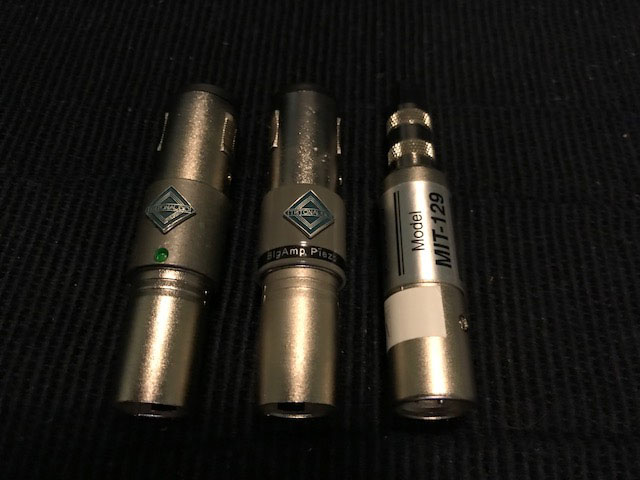I’ve been primarily using Triton Audio’s BigAmp Piezo preamps for piezo-based contact mic and hydrophone recording for years now. I previously used Hosa MIT-129 impedance matching transformers for the job, but I found that the BigAmp Piezos yielded me a better low frequency response thanks to the higher impedance. The Hosa MIT-129 hs a 50 kilaohm input impedance whereas the BigAmp Piezo has 7.5 Megaohm input impedance. Add to that the additional gain from the active preamp and you start to see why I generally prefer the BigAmp Piezo.

In initial listening tests years ago I found that the BigAmp Piezo produced a wider frequency response generally, and it felt like it had a quicker transient response, when compared to the Hosa MIT-129. This sort of rounding off is as expected from the passive transformer, and is actually a pleasing, more analogue effect of the passive transformer device in some ways.
I also have a Barcus Berry 4000XL Piezo/Buffer/Preamp which has an input impedance of 2.2 Megaohms. This results in a fairly similar low frequency response to the BigAmp Piezo, but it has a much lower amount of gain compared to the BigAmp Piezo.
What about noise?
Noise can be a complicated issue, as you need to take into account how the impedances of the devices interact, and then there are differences at different frequencies. My comments below are based on my testing using a Sound Devices 788T with the inputs linked for precise gain matching.
I have found a little bit of variability in the self noise of the BigAmp Piezos – not heaps, but a little bit. In theory the Hosa MIT-129 has no self noise as such since it is a passive device, but when I compare a level matched recording under controlled conditions from a BigAmp Piezo and a Hosa MIT-129 I find that the BigAmp Piezo has a little less noise, but it is possible I am getting tricked in my level matching because of the tonal response differences.
I have found the Barcus Berry 4000XL to provide a similar amount of noise to the Hosa MIT-129 when I compare a level matched recording under controlled conditions. So overall the BigAmp Piezo sounds the cleanest for the equivalent amount of gain/signal, although again, it is possible I am getting tricked in my level matching because of the tonal response differences. The Hosa MIT-129 gives a thinner response overall with more high frequency hiss when relatively level matched.
What about matching?
As mentioned above, I have found a little bit of variability in the self noise of the BigAmp Piezos. Not enough to be a problem for most applications.
I have 6 x BigAmp Piezos, 4 of which are an older design and another 2 which I recently got that look a little bit different. The older design has a Triton Audio badge on it with a green dot below it, but no other text on the unit. The newer design has a different grey paint finish with no green dot, but it does have text on it (BigAmp Piezo :: made in Holland). In my testing I have found that the newer units have more low frequency response under around 100 Hz. The self noise profile of the newer ones seems to have a bit of a boost in the mids centred around 750-1,000 Hz. The specs sheets provided with both the newer and older units has exactly the same specifications on it, so I emailed Triton Audio to get confirmation of what I had found and they advised that there is “an extended low frequency response. Frequency response should be flat.”

In terms of frequency response, the 4 x older units I have are all quite similar to each other.
I have 6 x Hosa MIT-129s and I have found them all to have a very similar frequency response and amount of noise, so they match each other really well. As a simple passive device they shouldn’t have any self noise as such.
Conclusion
Using some form of preamp/buffer (active DI) or impedance matching transformer (passive DI) with piezo pickups is important if you want to capture a wider frequency response. The active Triton Audio BigAmp Piezos are an excellent low noise option with a great compact form factor for use in the field and are my preferred option. A cheaper option that doesn’t give quite the extended low frequency response is the passive Hosa MIT-129 impedance matching transformer. Being a passive option I would suggest it is probably a bit more rugged and less likely to have issues develop over time.

Great write up Tim. I’ve been wondering how the bigamps perform for a while and this answers those questions.
Also the Hosa transformer looks like a good option too. The LF roll off could be beneficial in some circumstances. Having both in the bag seems like a good combination.
Cheers?
Hello Tim, thanks for sharing. I have a Triton BigAmp but i get a lot of noise when i use it with my Zoom HN5 and some piezo mics i’ve been building. It clearly improves the sound and low response of the piezos but when i turn the recorder imput level above 3 or 4 the noise is very high.
¿Is it normal?
another dummy question ¿is it necessary to use a XLR cable between the Zoom recorder and the Triton preamp? when i isert the preamp direct in the recorder i get no sound (i’m using the phantom)
thanks in advance
Best
Rubén
Hi Ruben, thanks for your comments.
That is interesting what you say about the noise using the Zoom H5n. I’m not 100% sure, but this could be noise from the Zoom H5n’s preamp. While Zoom is improving their quality, their preamps have generally been not that great.
The other thing is, are you using the BigAmp Piezo, or just the Bigamp (non-Piezo version)? Might make a little difference to the response.
You shouldn’t need to use an XLR recorder between the Zoom recorder and the Triton preamp. That is really odd that you are getting no sound when you plug it directly into the recorder, and it doesn’t really make sense to me unless there is an issue with how well the BigAmp is connecting with the Zoom’s XLR input. Have you tried both XLR inputs? Does it feel like the XLR latches in firmly?
Cheers
Tim
Hello Tim, thanks for answering. I’ve tried both XLR imputs ant the behaviour is the same. Strangely i think it owrks with the XLR imput of my audio interface. I’ve done some tests, you can hear them here: https://drive.google.com/drive/folders/13L4OvfyVwmBNEw68zqBJWtPzQuKAM1EE?usp=sharing
thanks
Rubén
Thanks Ruben. That is strange. That doesn’t sound like preamp noise – it sounds more like a grounding or power issue. Can you send me a clearer photo of the solder side of your piezo and your 1/4″ phone plug so I can take a look at how you are wiring things?
Do you have other contact mics that you didn’t make that you can test with and do they give the same results?
Hello Tim, thanks for answering, i think i’ve solved the problem…strange, but it works perfect!!
Strange as it sounds, the way i’ve managed to remove the noise (it was grounding as you say) was to remove the screw that holds the female jack with the metal body of the BIgAmp Piezo….
With this, i can plug the Bigamp directly to the ZOOM H5 and i have no noise.
i’m connecting a piezo mic based on this one (https://www.phase57.com/build/contact-mic/) using a balanced jack (with 3 cables: red and black form the piezo disc, and a 3rd for the shielding).
the funny thing is that to operate without the ground noise and to make the shielding in the piezo disk work i’ve done this:
1- As the jack male connector has 3 parts, L, R and ground, i’ve soldered the piezo red cable to the L, the cable shield to R, and the shield to R
2- in the female jack piece of the BigAmp PIezo, there are three pins, but they only use 2, the ones that matches the L and the ground. So i’ve connected a small piece of cable to the third pin (part R of the jack head) and glued it with electrical tape to the metal body of the piezo….
i don’t know if this make sense in a electrical way… ^_^but the thing is that the mic works perfectly, no ground noise and i can increase the zoom gain volume almost to the top without any interference, and get a lot of beautifull low frequencies ….
thanks for your help
best
Rubén
Wow – that does seem strange!
Anyway, glad you at least figured it out even if it is so weird.
The Triton Audio BigAmp Piezo is expected to see an unbalanced TS phone plug. When I have made piezo contact mics I have always used TS phone plugs rather than TRS as you have used, and I suggest that doing that would have probably avoided the issues you are having, but it is different to the design on that link you shared.
Hi Tim, thanks for the article – it has addressed a lot of my questions! I still can’t quite decide between the Hosa and the Triton though.
The Hosa is considerably cheaper but I don’t want to make a false economy. How significant is the difference in low-frequency response? And is this something I could remedy with EQ?
I spoke to Jez Riley French about similar questions a while ago and he said he’d had interference from multiple sources when testing the Triton BigAmp Piezo – an issue he presumably doesn’t have with the Hosa, given that he sells them on his site. Have you had any issues with interference on either?
Thanks!
Bernie
Thanks for your feedback Bernie. Glad the article is useful for you.
I haven’t been using contact mics and hydrophones much lately, so I feel slightly underqualified to give much guidance without digging back into it. I suggest the low end response is small but noticeable. You might be able to remedy a small amount with EQ, but due to the impedance interactions causing more of a high pass filter effect for the lower impedance MIT-129 it might not achieve a full proper remedy.
Interference might have been a thing actually, but I don’t recall it being an issue much for what I was doing. Again, I feel like I need to dive back into using these again more to feel more qualified with my response.
Let me know how you go with it.
Tim